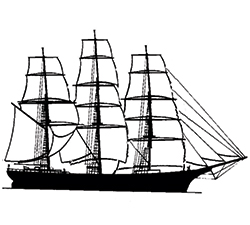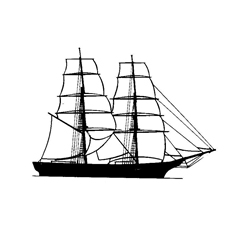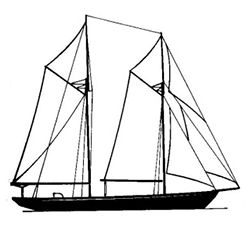Heritage Pt 2 – Prelude to War on the Upper Lakes

Article: John Jamieson Images: Huronia Museum
The main supply route from Britain to Upper Canada during the war was by ship to Montreal, then by boat along the St. Lawrence River to Prescott or Kingston and onwards to York and Niagara by schooner on Lake Ontario. Control of the sea was necessary to secure these routes in wartime but the nondescript collection of coast guard like Provincial Marine vessels that existed on the Lakes during peacetime in the early 1800’s was no match for an enemy naval force during times of war. Both navies used the following three types of vessels on the Great Lakes during the War. The tall ships still use these main types or variations on the theme.
THE SHIP. The ship rig was used for the largest of the three types (first rates, frigates and corvettes). They were fitted with three masts, the foremast and mainmast were square rigged and the mizzen (aftermost) had a combination of square and a fore and aft sail. HMS St. Lawrence was the only first rate to become operational before the War’s end. She displaced 2304 tons and sported 112 guns. Frigates were the mainstay of the larger warship type on the Lakes, carried anywhere from 20 to 60 guns and displaced between 600 and 1600 tons. The corvette was the smallest of the ship rigged vessels, normally displaced 500 to 600 tons and carried up to 20 guns. The number of guns carried by ships in both navies varied as they were moved from ship to ship or land batteries as required.

THE BRIG. A brig had two masts, with square sails on both and a large gaff on the mainmast (aftermost mast of the two). They normally carried 10 to 24 guns, displaced from 100 to 500 tons and were relatively deeper draught and more stable than the smaller schooners. Stability was an issue and the size and location of the larger guns had to be positioned carefully to ensure that they did not become too top heavy
 THE SCHOONER. The schooner normally displaced 60 to 100 tons and had two masts with fore and aft sails on both, often with a square sail on the foremast. It could sail closer to the wind than the square rigged brig and ship (to provide a point of comparison for size, the Discovery Harbour schooner replicas Tecumseth and Bee displace 150 and 30.5 tons).
THE SCHOONER. The schooner normally displaced 60 to 100 tons and had two masts with fore and aft sails on both, often with a square sail on the foremast. It could sail closer to the wind than the square rigged brig and ship (to provide a point of comparison for size, the Discovery Harbour schooner replicas Tecumseth and Bee displace 150 and 30.5 tons).
THE PROVINCIAL MARINE
At the start of the War, the Provincial Marine had two corvettes, two brigs and two schooners on Lake Ontario, one of each on Lake Erie and the Americans one 16 gun brig on Lake Ontario and nothing on Lake Erie. After the Americans declared war in June 1812, they augmented their fleet with lakers fitted out as warships. The British blockade of the eastern seaboard prevented many American ships from putting to sea which freed up naval personnel and equipment to feed the growing fleet on Lake Ontario. The United States Navy, although small, was in reasonably good shape when war was declared as the young republic had been at war with France and Tripoli from 1798 to 1805. These two conflicts, fought almost entirely at sea, provided an invaluable training ground for the fledgling American navy. Consequently, the Provincial Marine did not fare well in their first brush with the burgeoning enemy fleet in November 1812 and the Governor General of Canada, Sir George Prevost, removed many of the senior officers (one was over 80 years old) and had the Royal Navy take over early in 1813. By the end of the War the two Lake Ontario fleets had grown to 11 ships for the British (including one first rate and four frigates) and nine (including two heavy frigates) for the Americans.
Command of the Lake depended on which navy had the strongest fleet at the moment and a naval arms race ensued in an attempt to maintain this control. Both Commodores were loath to risk losses such as those experienced on Lake Erie where the British fleet was captured by a superior American force in September of 1813. The Americans retained command of Lake Erie for the rest of the War which greatly facilitated the American land campaign on the Niagara peninsula in 1813-14. It also had a direct impact on the naval war in our neck of the woods.
The major player in the naval arms race was the ship designer and builder (often the same person). Designs had to consider the fact that lake ports were shallow and ship’s hold depths and bottom shapes were modified to reduce draught. As there was not as much need for water tankage and storage space, more room was available for one of their primary roles as troop transports. The innovations in ship design driven by the quest for speed for blockade runners and privateers on the coast did not make it as far as the Lakes, probably because the arms race was more concerned with quantity than quality.
The design of American ships differed from the British in two important areas. Frigates were larger (they were referred to as super frigates) and carried more guns (many of them long guns). British ships were fitted with a preponderance of carronades, a weapon which was lighter, fired a heavier round but had a third of the range of the long gun. It was originally designed as an auxiliary weapon to the main armament and used to smash the enemy at short range. For some reason, the British lost sight of its original purpose and had to learn the hard way in the early part of the War as it gave a range advantage to the Americans. Needless to say, the British fleet was equipped with many more long guns towards the end of the War.
Ship design and designers played a significant part in how successfully sailing ships carried out their role during most of the 19th century. Trade requirements pushed the envelope in the search for speed under sail and were responsible for the designs that were implemented in the blockade runners, privateers and later the Baltimore Clippers. All of these improvements culminated in the ultimate go fast design, the Clipper Ship. That is until we get to the types of vessels that Steve Killing is involved with and he will be speaking on this fascinating story at the Huronia Museum Heritage Dinner on the 3rd of May.
Part 2 of 3 in Series
Read Part 1 of Heritage Series | Read Part 3 of Heritage Series




























